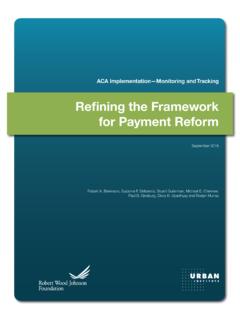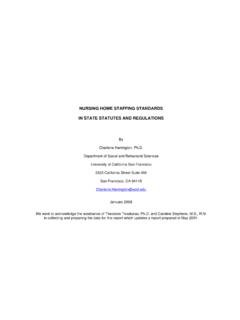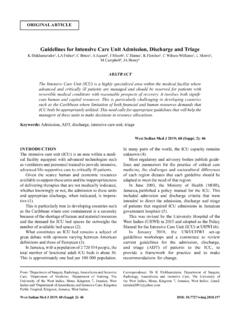Transcription of The Pros and Cons of Single-Payer Health Plans
1 Linda J. Blumberg and John Holahan March 2019 One of the often-discussed proposals to reform the Health care system is a Single-Payer plan, sometimes called Medicare for All. Arguments for and against are wide ranging. There is also considerable confusion as to what single payer means and how it might operate. For example, some people use single payer and Medicare for All interchangeably with universal coverage. Consequently, we present both a general picture of the most frequently mentioned Single-Payer proposal, and we delineate the advantages and disadvantages of the approach without taking a position on its advisability. Such clarification is necessary to advance a constructive debate over next steps for improving the US Health insurance system . We first make five contextual points that are critical to better understanding the debate around Single-Payer Plans , as well as our list of pros and cons.
2 First, we must clarify that creating a system that leads to universal coverage can be accomplished in many ways; a Single-Payer plan is just one approach among many. In fact, most countries with universal Health insurance programs do not have Single-Payer Plans ; they largely rely on multipayer Second, even Single-Payer Plans can vary in design. At their core, however, they consist of a government-designed and run insurance plan that all members of a population ( , a country or state) are eligible for and ultimately enrolled in. The insurance plan s costs are financed through a system of government revenues. However, Single-Payer approaches can vary in which benefits they cover, the out-of-pocket costs required when enrollees use medical care , the mechanisms through which or the levels at which Health care providers are paid for their services, and the sources of revenue that finance H E A L T H P O L I C Y C E N T E R The Pros and Cons of Single-Payer Health Plans 2 T H E P R O S A N D C O N S O F S I N G L E-P A Y E R H E A L T H P L A N S the system .
3 In its purest form, a Single-Payer approach implies one financer of Health care for the population ( , the government), and that entity assumes all of the Health care risk associated with the enrollees, meaning no other insurers are envisioned as part of the system . A single payer does not necessitate government ownership of hospitals or direct employment of physicians and other personnel but does eliminate private Health insurance for any benefits covered by the new program. National Health spending (the sum of public and private spending) under a Single-Payer system could increase or decrease, depending on the extent to which the generosity of benefits covered increases relative to current coverage; use of services increases because of lower out-of-pocket costs and more people insured, accounting for any utilization controls; provider payment rates can be reduced; and administrative costs of insurance can be cut.
4 Third, the current Medicare program is not a Single-Payer plan. It is a multipayer program that includes a government-run plan, enrollee premiums, an array of private insurance options, and significant beneficiary cost -sharing requirements. Therefore, the current Medicare for All bills do not equate to putting all Americans into the Medicare program; they would create a new government insurance program for all Americans, eliminating all other Health insurance, including the current-law Medicare and Medicaid programs. Medicare, the federal insurance program for those ages 65 and older and certain people with disabilities, has multiple components, including a range of participating private insurers. Eligible individuals can pick traditional Medicare, consisting of Parts A (hospital care ), B (physician care ), and D (prescription drugs), or, alternatively, Part C (Medicare Advantage).
5 Medicare-eligible people who do not choose Part C enroll in the traditional Medicare option s Part A and are given the choice of enrolling in parts B and/or D. Each component of the program has its own applicable out-of-pocket costs; parts B and D each have associated premiums paid by enrollees but no overarching out-of-pocket maximum. Each of parts A and B are administered by the federal government as fee-for-service Plans ,2 but part D is offered and administered by private prescription drug Plans under contract with the federal government. In addition, many traditional Medicare enrollees also purchase supplemental insurance Plans sold by private insurers in the Medigap market or through employer-based private insurance Plans . Those taking the Medicare Part C option do not enroll in a government-administered public plan; they choose among a selection of private insurers that operate under federal regulations and contracts.
6 These private insurers bear risk for the Health care costs of their enrollees. Some charge premiums to beneficiaries and some do not. In addition, benefits covered by the Medicare program are set in statute; they are generally comparable to the essential Health benefits covered by Affordable care Act Plans , but they do not include benefits such as adult dental, vision, and long-term services and Fourth, our pros and cons of a Single-Payer plan, presented below, focus on the most frequently mentioned approach to this type of reform, that championed by Senator Bernie Sanders in his 2016 T H E P R O S A N D C O N S O F S I N G L E-P A Y E R H E A L T H P L A N S 3 presidential bid (similar to the Senate bill he introduced following that campaign, S. 1804, but which has yet to be reintroduced in the 116th Congress, and 1384, a similar bill introduced in February 2019 by Congresswoman Pramila Jayapal, which updates an earlier bill sponsored by former Congressman Keith Ellison).
7 This approach would provide coverage for all US residents for all medically necessary care within a broad set of benefits including dental, vision, hearing, and, in 1384 but not S. 1804, long-term services and supports. There would be virtually no out-of-pocket costs for services provided, the program would prohibit private insurers from selling coverage for benefits provided through the public system , the government would reimburse Health care providers at levels related to the current-law Medicare program, and one proposal would use global budgets to pay institutional As noted, Single-Payer systems could be designed in different ways ( , with less expansive benefits, cost -sharing requirements, different levels of provider payments), but because the approaches of S. 1804 and 1384 are currently the focus of significant support among some presidential hopefuls and an array of vocal consumer advocates, this is the framework on which we delineate advantages and disadvantages.
8 Many of our points could be easily adjusted to account for modified versions of this framework. Fifth, a Single-Payer system would constitute a major change in the way Health care is financed in the US. There would be strong political resistance to the approach from providers, private Health insurers, those invested in Health care systems, the pharmaceutical and medical device industries, and some people satisfied with their current insurance. The political resistance to the Affordable care Act, a much less ambitious and decidedly more incremental set of reforms than a Single-Payer approach, was tremendous and has continued since its enactment in 2010. The financial stakes for Health care providers, manufacturers, and taxpayers are all far larger under a Single-Payer system . In addition, many Americans are wary of disruption and change, and a significant segment is likely to oppose giving up what they have and know for something new and untested.
9 Recent polls show evidence of significantly decreased support of a Single-Payer approach once respondents are told the plan would eliminate employer-based Pros Universal coverage. All members of the eligible population would be insured or would become insured when seeking to access Health care Coverage would also be continuous: people would not lose coverage or need to change coverage when their jobs, family status, income, state of residence, or age change. Equity. All US residents would have the same coverage. This would go a very long way toward redressing racial/ethnic and income-related disparities in coverage and access to care . Affordability at point of service. With no premiums, no out-of-pocket costs, and a broad set of medically necessary benefits covered (including services for any preexisting conditions), the cost of care would be spread across all taxpayers.
10 Financial burdens would no longer fall 4 T H E P R O S A N D C O N S O F S I N G L E-P A Y E R H E A L T H P L A N S disproportionately on those with serious Health problems, and segmentation of Health care risks would be eliminated. Access to care . With broad benefits and no out-of-pocket costs at the point of service, access to care would increase, particularly for those with low or modest incomes. In addition, by including benefits such as long-term services and supports, dental, and vision, even many higher-income people should have increased access to some services. In principle, improved access would tend to improve Health . See below for a caveat on potential increases in demand relative to the supply of Health care providers. Broad-based implementation of cost - containment strategies.
















